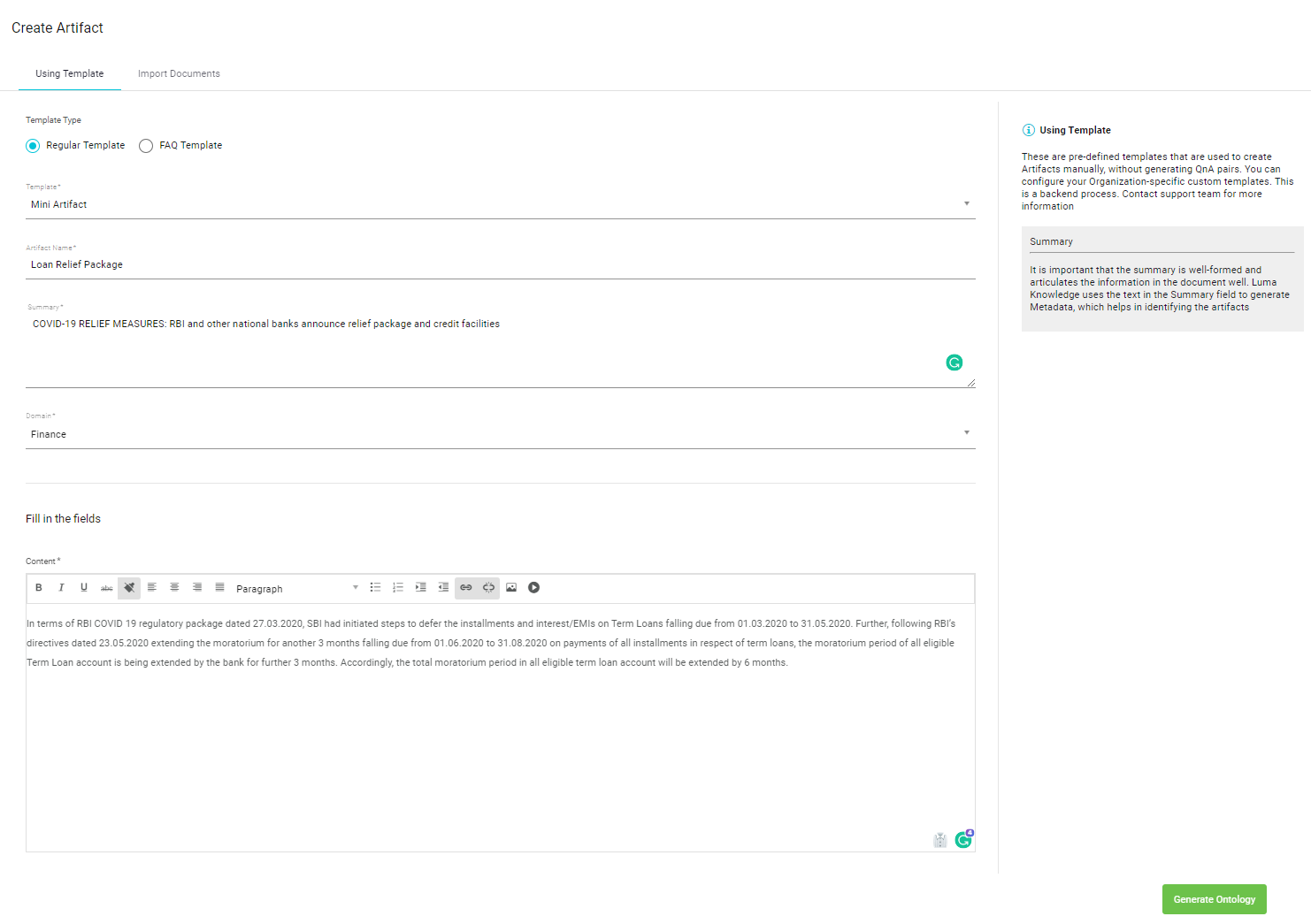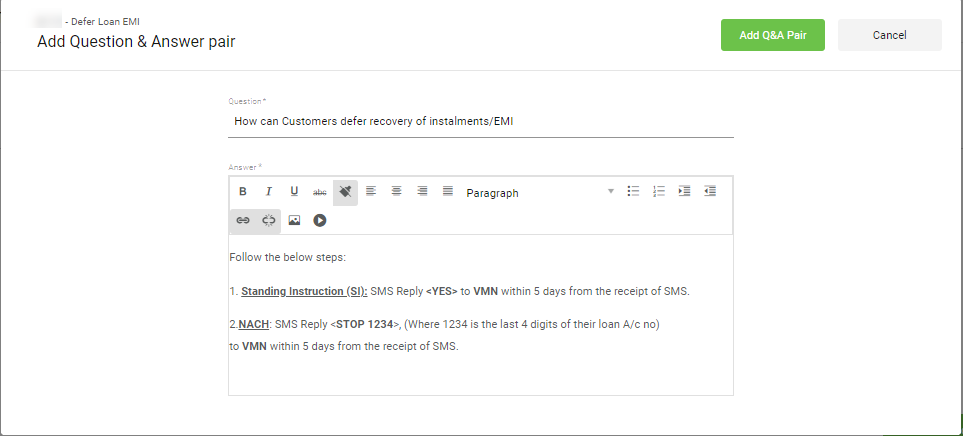Luma Knowledge provides predefined Templates that can be used by a Curator to generate Artifacts. These define the artifact type and required fields. Using these Templates, Curator can manually create Knowledge Artifacts by adding information content and generate Ontology to extract metadata. The Artifacts created using Templates do not go through the Semantic Analysis process i.e. generating FAQs, parsing, and Normalization.
There are two type templates available in Luma Knowledge:
Regular Template
FAQ Template
Artifact Templates are used to define an artifact type. The selected template determines the mandatory and optional fields required to create the Artifact.
Using Regular Template
Regular Template allows a Curator to create Artifacts using the organization-specific templates available in Luma Knowledge. These artifacts do not degenerate into QnAs. So, the complete Artifact is returned as a result of the User’s inquiry.
Organization-specific custom templates are configured in Luma Knowledge to create Artifacts manually. Refer to /wiki/spaces/DOC/pages/26179469332for more details.
Follow the below steps to create an Artifact using the Regular Template:
On the Create Artifact window, navigate to Using Template tab.
Select Regular Template as Template Type.
On the Template list, select the required Knowledge Template.
Add Artifact Name.
Add Summary. It is important that the Summary is well-formed and articulates the information in the document well. The text in this Summary field is used by the NLP engine to generate Metadata.
Select a Domain from the Domain list. This represents the area, department, region, or field the Artifact belongs to. The Domains available on the list are available out-of-the-box. To update the list, refer to Adding a new domain on Knowledge Graph.
Now based on the selected template add information in the Content fields.
Once the content is ready, Click on Generate Ontology.
The Artifact is now created in Luma Knowledge and is available in the Knowledge store.
'Generate Ontology' step extracts values for metadata attributes like Parent Topic, Action, Motivation based on the Summary added in Step 5. On click of Generate Ontology, the NLP engine parses the information added to the Artifact and identifies the metadata, which is used to understand the user’s intent during the search.
As a Curator, you should verify and ensure that metadata generated by the system is correct and Artifact is related to the correct Topic. In case any changes are required,
Click on Edit.
Add the required keyword to metadata fields and Save Changes.
Based on the Artifact Publishing Mode configuration for your tenant and the identified metadata, the Artifact state is determined :
Publish if basic metadata available: If Luma Knowledge identifies the mandatory metadata, i.e. Topic, Subjects, and Actions, Artifact is automatically set Published state. If the metadata is not found, Artifact is set to Draft state.
Publish Draft: Artifact is set to Draft state and must be reviewed and Published manually.
Publish Anyway: Artifact is automatically Published, with or without mandatory Artifacts.
Refer to Tenant Configurations for more information.
Click on View Artifact to view the Artifact in the Knowledge Store.
You can Publish the Artifact to make it available for end-users to search and consume. Refer to Knowledge Store for more information.
Click on Go To Dashboard, to navigate to the Luma Knowledge dashboard.
In case the Summary field is empty, information added to the Summary field on the selected template is automatically added as Artifact Summary and used to generate Ontology for the artifact. To add a different artifact summary, add the information in the Summary field.
Fields marked as Hidden in the selected template are not available for the curator while creating an Artifact manually. The fields are only used when the artifact is created by importing a Document with a template.
In case a Topic is not identified during the Ontology Generation, the Artifact is automatically linked to the selected Domain. The Artifact must be linked to the correct Topic in Knowledge Graph before it is published. Refer to Knowledge Graph for more information.
If the selected template contains a 'Redirect Link' field, any artifact associated with the template when accessed through Luma Virtual Agent redirects to the URL added to the field in a new browser window.
Using FAQ Template
FAQ Template allows a Curator to create an Artifact and add Question and Answer (Q&A) pairs to hold knowledge. For each Q&A pair, Ontology analysis is performed, generating metadata for the content as well as Q&A pairs. These Q&A pairs are registered as FAQs that are linked to the Artifact as well as the topic identified during Ontology generation.
Below are the steps to create an Artifact using the FAQ Template:
On Create Artifact window, select Template.
On the Create Artifact window, navigate to Using Template tab.
Select FAQ Template as Template Type.
Add Artifact Name.
Add Summary. It is important that the summary is well-formed and describes the information in the document well. The text in this field is used by the NLP engine to generate Metadata.
Click on Add Q&A Pairs.
Add Q&A Pairs
In this step, the system allows you to add one or more Q&A pairs. Information in these pairs is used to generate related metadata attributes like Parent Topic Action, Motivation for each Q&A pair.
Click on Add Q&A Pair to add new QnA pairs
On Add Questions & Answer pair screen, add details. Once done, click on Add Q&A Pair button.
The Q&A is added to the list. You may add multiple Q&A pairs to the Artifact.
On the Artifact page, Click on Generate Ontology.
The Artifact is now created and available in Knowledge Store. Information added to these Q&As should be well-formed as this ensures that the Ontology process is able to extract correct values for metadata attributes.
Based on the Artifact Publishing Mode configuration for your tenant and the identified metadata, the Artifact state is determined. For more information, refer to Tenant Configurations.
Generate Ontology
Click on Generate Ontology to extract values for metadata attributes like Parent Topic, Action, Motivation for the Artifact based on the Summary. For the Q&A pairs, metadata is generated based on the information added in the Question and Answer fields. On click of Generate Ontology, the NLP engine parses the information added to the Artifact and identifies the metadata, which is used to understand the user’s intent during the search.
As a Curator, you should verify and ensure that metadata generated by the system is correct and Artifact is related to the correct Topic. In case any changes are required,
Click on Edit.
Add the required keyword to metadata fields and Save Changes.
Click on View Artifact to view the Artifact in the Knowledge Store. You can Publish the Artifact making it available for end-users to search and consume. Refer to Knowledge Store for more information.
Click on Go To Dashboard, to navigate to the Luma Knowledge dashboard.
An Artifact is not available for End Users to search and consume unless it is Published by the Curator.
In case a Topic is not identified during the Ontology Generation, the Artifact is automatically linked to the selected Domain. The Artifact must be linked to the correct Topic in Knowledge Graph before it is published. Refer to Knowledge Graph for more information.
The metadata for the QnA pairs can be updated in the Knowledge Store.








Add Comment